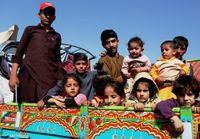On Wednesday, October 22, 2025, the ongoing humanitarian crisis facing Afghan refugees reached a new and troubling milestone. According to the Taliban-run Bakhtar News Agency, a total of 599 refugee families returned to Afghanistan that day, entering through various border crossings: 47 families via Pul-e Abrasham in Nimroz, 117 through Islam Qala in Herat, 419 through Spin Boldak in Kandahar, and 16 through Bahramcha in Helmand Province. This wave of returns follows a similar exodus just two days earlier, when more than 600 families also crossed back into Afghanistan. These numbers, while stark, represent only a fraction of the tens of thousands of Afghans being pushed out of neighboring countries in a matter of weeks.
The forced return of Afghan refugees is not a new phenomenon, but the scale and speed of the current expulsions mark a dramatic escalation. Millions of Afghans have fled their homeland over the past four decades, seeking safety and opportunity in Iran and Pakistan as Afghanistan endured civil war, foreign intervention, and more recently, the return of Taliban rule. Yet, as reported by Geo News and other outlets, these refugees have often found little respite. Instead, many have been forced into precarious, marginalized existences—and now, even that fragile security is rapidly unraveling.
In Pakistan, the government has taken a particularly hard line. On October 22, 2025, local authorities in the Lower Dir District of Khyber Pakhtunkhwa province informed Afghan refugee leaders that all camps in the region had been "de-notified" and that all previously offered facilities would be withdrawn. Assistant Commissioner of Timergara, Zaid Safi, along with District Administrator Humayun Khan, informed refugees that transport would be arranged to the Torkham border. Safi made it clear that, "the government would use force if the refugees refused to return voluntarily," according to reporting by Dawn. He did add a glimmer of empathy, saying he hoped it would not come to that, and urged refugees with outstanding loans to share their details with his office. But the message was unmistakable: the era of hospitality was over.
The impact is immense. More than 40,000 Afghan refugees, including 4,500 families, currently reside in camps and rented houses in Lower Dir alone. Of these, 33,681 have proof of registration cards, and another 6,100 possess Afghan citizen cards, according to official statistics. More than 3,000 Afghan refugees also live in Upper Dir. So far, 565 people from 100 families have returned to Afghanistan voluntarily, but the local administration has requested additional funds from the provincial government to make transportation arrangements for the rest. The pressure is mounting, and the options for these families are dwindling fast.
The situation in Karachi, Pakistan’s sprawling southern metropolis, is even more dire. Since October 15, 2025, Pakistani police have demolished approximately 1,200 houses out of more than 3,000 that were vacated by Afghans in the United Nations-designated Afghan camp in Sohrab Goth. As Dawn reported, more than 14,000 Afghans had already vacated the camp by October 22, with the operation to demolish the remaining homes expected to conclude within days. The camp, once home to around 15,680 Afghans, now has only 1,384 residents left, all of whom are being repatriated in phases. Senior Superintendent of Police Tariq Illahi Mastoi explained that the operation was being carried out in accordance with federal policy, citing concerns about illegal land occupation and potential breaches of peace. Initial resistance from alleged land mafias faded quickly, and the demolitions proceeded with little further hindrance.
These actions are not isolated. Across the southwestern province of Balochistan, Pakistan has locked down ten refugee camps and, according to Geo News, forcibly expelled more than 85,000 Afghans in recent weeks. The crackdown has been particularly intense in Quetta, where, on October 21, 2025, authorities arrested 3,800 Afghans living illegally in the city as part of a broader operation that has seen 3,888 Afghans detained. The precise whereabouts of these individuals remain unclear, but it is widely believed that all have been expelled from Pakistan.
The roots of this mass expulsion can be traced, at least in part, to the recent surge in violence between Pakistan and Afghanistan. After Pakistani airstrikes targeted Afghan territory, the Taliban retaliated by seizing several Pakistani military posts. The resulting clashes killed hundreds on both sides, and the reverberations have been felt most acutely among Afghan refugees in Pakistan. In the wake of these events, the Pakistani government announced that all Afghan refugees must leave the country as soon as possible—a directive now being enforced with increasing vigor.
For many Afghans, the journey back home is fraught with uncertainty and danger. Afghanistan itself remains deeply unstable, with the Taliban’s return to power in 2021 leading to widespread economic collapse, food shortages, and continued violence. The sudden influx of tens of thousands of returnees only adds to the country’s challenges. Humanitarian organizations have warned that Afghanistan simply does not have the resources to absorb such large numbers of people in such a short time. Basic services—housing, healthcare, employment—are already stretched to the breaking point.
The plight of Afghan refugees has long been a difficult balancing act for Iran and Pakistan, both of which have hosted millions of Afghans over the decades. Yet, as Geo News and other outlets note, the welcome has always been conditional, and often tinged with suspicion. The latest wave of expulsions is a stark reminder of that reality. As one report put it, "these Afghans did not find a better life; instead, Muslim countries have forced them into a miserable existence." The words are harsh, but for many, they ring true.
While the Pakistani government justifies its actions as necessary for national security and social order, critics argue that the mass expulsions are both inhumane and counterproductive. The United Nations and international human rights groups have repeatedly called for greater protection of refugees’ rights and for more sustainable, dignified solutions. Yet, as the events of October 2025 make clear, the political will for such measures remains elusive.
Back in Afghanistan, the Taliban have been quick to publicize the return of refugees, perhaps seeking to project an image of stability and national unity. But the reality on the ground is far more complex and precarious. As thousands of families cross back over the border, they face an uncertain future—caught between the hostility of their former hosts and the daunting challenges of rebuilding their lives in a country still reeling from decades of conflict.
The forced return of Afghan refugees from Iran and Pakistan is not just a regional crisis; it is a humanitarian catastrophe unfolding in real time. The numbers are staggering, the stories heartbreaking, and the solutions, for now, remain desperately out of reach.





